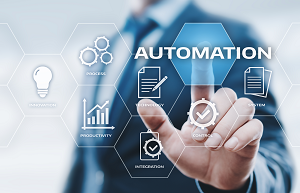A recent report from McKinsey estimates that generative AI could add the equivalent of $2.6 trillion to $4.4 trillion of business value to the economy annually. Speculated as one of the tech industry’s next great leaps, akin to the Industrial Revolution, the hype around generative AI’s impact is at an all-time high.
But, if you’re investing in hyperautomation and process orchestration, which types of AI can demonstrate the most immediate value? Where are the biggest areas of promise for the next two to five years? Let’s take a look at some practical ways to apply AI into your automation workflows today and in the near future. The key takeaway? Generative AI is only a part of the picture.
1. Generative AI
Gartner reports that 70% of companies are in exploration mode with generative AI. We’re just beginning to scratch the surface on potential applications. In automation specifically, generative AI can be used to augment human workflows to make mundane tasks like form completions and data extraction much faster to execute.
When it comes to designing process models themselves, developers may soon rely on code generators like GitHub Copilot to accelerate the process. In the testing phase, generative AI could be used to automatically generate testing data to ensure that end-to-end processes are working optimally.
2. Predictive AI
Perhaps one of the most significant areas where AI can make an impact on automation is predictive modeling. Process complexity is one of the top areas of concern for implementing effective automation. According to the 2023 State of Process Orchestration survey, 72% of IT leaders agree that real-world, mission-critical processes are becoming more complex to maintain. As more tasks become automated to meet customer experience demands, 69% say it is harder to visualize end-to-end processes.
While predictive AI is nothing new, combining predictive models with process execution data can help teams visualize where their processes are performing well, where they need improvement, and how to design future processes so they operate at optimal performance. For decision modeling, predictive AI can help with certain processes, such as predicting instances of fraud in a financial services fraud detection system, based on previous user data.
3. Augmented Intelligence
Augmented intelligence is perhaps one of the most exciting and under-the-radar types of AI that can improve human productivity. This type of AI can help accelerate decision-making that normally would have been done by a human, thereby accelerating the efficiency of a process. This has the potential to be very significant, since three billion business decisions are made per year. Research from Bain shows a 95% correlation between decision effectiveness and financial performance.
In automation, augmented intelligence can be used to build self-healing processes. An augmented intelligence system could take process execution data analysis to the next level by deciding how to make a process more efficient, and then executing on that decision with minimal or no human intervention. In the automation testing process, augmented intelligence could generate test-cases for certain types of functions, such as form fills. For example, the system could generate test data on what could potentially go wrong when humans fill out a form, and auto-correct errors for cleaner data collection.
When combined with other technologies and relevant datasets on process execution, organizations can become far more efficient and effective in reaching their automation goals. It’s important not to be distracted by hype, and to be open-minded to the possibilities of trying multiple types of AI technology to achieve the greatest possible impact. While we’re still in the early stages of discovering the full impact of AI in automation, there’s exciting potential to make great efficiency leaps using the tools and technology available today.
About the Author

Jakob Freund is co-founder and CEO of Camunda – responsible for the company’s vision and strategy. He’s also the driving force behind Camunda’s global growth and takes responsibility for the company culture. As well as holding an MSc in Computer Science, he co-authored the book “Real-Life BPMN” and is a sought-after speaker at technology and industry events.
Sign up for the free insideAI News newsletter.
Join us on Twitter: https://twitter.com/InsideBigData1
Join us on LinkedIn: https://www.linkedin.com/company/insidebigdata/
Join us on Facebook: https://www.facebook.com/insideAI NewsNOW





Speak Your Mind